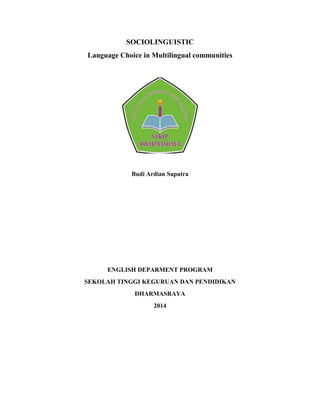Melden
Teilen

Empfohlen
Weitere ähnliche Inhalte
Was ist angesagt?
Was ist angesagt? (20)
Andere mochten auch
Andere mochten auch (7)
Ähnlich wie Multilingual
Ähnlich wie Multilingual (20)
21202244052_Ahmad Nuryusuf Widigdoyo_Petrusclaver Samudera Wicaksana.pptx

21202244052_Ahmad Nuryusuf Widigdoyo_Petrusclaver Samudera Wicaksana.pptx
21202244021_Bilingualism_Afiq Amalul Umam_Petrusclaver Samudra Wicaksana.pptx

21202244021_Bilingualism_Afiq Amalul Umam_Petrusclaver Samudra Wicaksana.pptx
Language in Multi-lingual Choice_Riyan Adisti (221060030).pptx

Language in Multi-lingual Choice_Riyan Adisti (221060030).pptx
21202244063_Lembayung Luh Jingga_Group Assignment PBI H.pptx

21202244063_Lembayung Luh Jingga_Group Assignment PBI H.pptx
Sociolinguistics - Chapter Two - Language choice in multilingual communities

Sociolinguistics - Chapter Two - Language choice in multilingual communities
21202244022_bilingualism_M Alif Daffa Ramadhan_Nofian Satria Pamungkas.pptx

21202244022_bilingualism_M Alif Daffa Ramadhan_Nofian Satria Pamungkas.pptx
21202244061_bilingualism_Nofian Satria Pamungkas_Nofian Satria.pptx

21202244061_bilingualism_Nofian Satria Pamungkas_Nofian Satria.pptx
Introduction of Sociolinguistics and describes Language variation, Linguistic...

Introduction of Sociolinguistics and describes Language variation, Linguistic...
21202244022_bilingualism_M Alif Daffa Ramadhan_Nofian Satria Pamungkas.pptx

21202244022_bilingualism_M Alif Daffa Ramadhan_Nofian Satria Pamungkas.pptx
Mehr von Bas Bas
Mehr von Bas Bas (7)
Kürzlich hochgeladen
Kürzlich hochgeladen (20)
Tech Trends Report 2024 Future Today Institute.pdf

Tech Trends Report 2024 Future Today Institute.pdf
Strategies for Unlocking Knowledge Management in Microsoft 365 in the Copilot...

Strategies for Unlocking Knowledge Management in Microsoft 365 in the Copilot...
Boost Fertility New Invention Ups Success Rates.pdf

Boost Fertility New Invention Ups Success Rates.pdf
From Event to Action: Accelerate Your Decision Making with Real-Time Automation

From Event to Action: Accelerate Your Decision Making with Real-Time Automation
The Role of Taxonomy and Ontology in Semantic Layers - Heather Hedden.pdf

The Role of Taxonomy and Ontology in Semantic Layers - Heather Hedden.pdf
The 7 Things I Know About Cyber Security After 25 Years | April 2024

The 7 Things I Know About Cyber Security After 25 Years | April 2024
Boost PC performance: How more available memory can improve productivity

Boost PC performance: How more available memory can improve productivity
What Are The Drone Anti-jamming Systems Technology?

What Are The Drone Anti-jamming Systems Technology?
Automating Google Workspace (GWS) & more with Apps Script

Automating Google Workspace (GWS) & more with Apps Script
Strategize a Smooth Tenant-to-tenant Migration and Copilot Takeoff

Strategize a Smooth Tenant-to-tenant Migration and Copilot Takeoff
08448380779 Call Girls In Diplomatic Enclave Women Seeking Men

08448380779 Call Girls In Diplomatic Enclave Women Seeking Men
Handwritten Text Recognition for manuscripts and early printed texts

Handwritten Text Recognition for manuscripts and early printed texts
2024: Domino Containers - The Next Step. News from the Domino Container commu...

2024: Domino Containers - The Next Step. News from the Domino Container commu...
Multilingual
- 1. SOCIOLINGUISTIC Language Choice in Multilingual communities Budi Ardian Saputra ENGLISH DEPARMENT PROGRAM SEKOLAH TINGGI KEGURUAN DAN PENDIDIKAN DHARMASRAYA 2014
- 2. CHAPTER I INTRODUCTION Language choice is provides a clear basic for comparing patterns of code choice in different speech communities. Will be easy to compare the varieties appropriate in similar domains in different speech communities. And a model is also useful to a newcomer in a community as a summary of the appropriate patterns of code use in that community.
- 3. CHAPTER II CONTENT Domains: domains of language use, a term popularised by an American sociolinguist, Joshua Fishman. A domain of language involves typical interactions between typical participants in typical settings about a typical topic. Examples of these domains are family, friendship, religion, education and employment. Setting: the physical situation or the typical place where speech interactions occur (code choice), settings such as home, church, mosque, school, office, etc. Diglossia: communities rather in which two languages or language varieties are used with one being a high variety for formal situations and prestige, and a low variety for informal situations (everyday conversation). Diglossia has three crucial features; two distinct varieties of the same language are used in the community, with one regarded as high (H) variety and the other as low (L) variety. Each variety is used for quite distinct functions; H & L complement each other. No one uses the H variety in everyday conversation. Example: the standard classical Arabic language is the high variety in Arab countries, and it is used for writing and for formal functions, but vernacular (colloquial) Arabic is the low variety used for informal speech situations. Polyglossia: basically polyglossia situations involve two contrasting varieties (high and low) but in general it refers to communities that regularly use more than two languages. Code-switching: it is to move from one code (language, dialect, or style) to another during speech for a number of reasons such, to signal solidarity, to reflect one's ethnic identity, to show off, to hide some information from a third party, to achieve better explanation of a certain concept, to converge or reduce social distance with the hearer, to diverge or increase social distance or to impress and persuade the audience (metaphorical code-switching) Lexical borrowing: it results from the lack of vocabulary and it involves borrowing single words mainly nouns. When speaking a second language, people will often use a term from their first language because they don't know the appropriate word in their second language. They also my borrow words from another language to express a concept or describe an object for which there is no obvious word available in the language they are using.
- 4. * Code switching involves a choice between the words of two languages or varieties, but Lexical borrowing is resulted from the lack of vocabulary.
- 5. CHAPTER III CONCLUSION After learn about Language Choice in Multilingual communities we can more understand about many kinds are like 1. Domains 2. Setting 3. Diglossi 4. Polyglossia 5. Code-switching 6. Lexical borrowing There are useful for you to know about the factor of language choice and multilingual communities
- 6. BIBLIOGRAPHY Holmes Janet. An introduction to sociolinguistic. Wellington, New Zealand. 1990.
